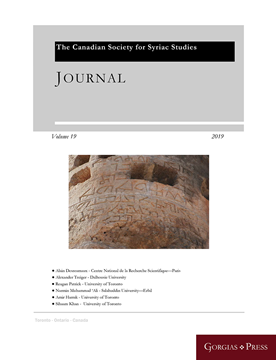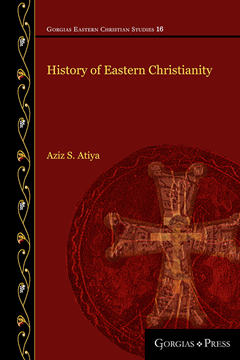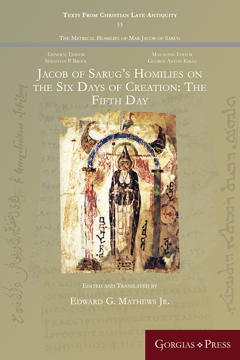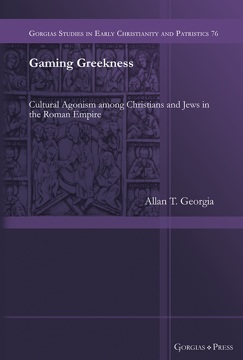Journal of the Canadian Society for Syriac Studies 19
ISBN: 978-1-4632-4111-7
A refereed journal published annually by the Canadian Society for Syriac Studies.
$75.00 (USD)
History of Eastern Christianity (paperback)
Series: Gorgias Eastern Christian Studies 16
ISBN: 978-1-4632-4115-5
This book is a classic in the history of the Oriental Churches, which are sometimes portrayed as heretical in general church history books, if mentioned at all. Written by a Copt, it portrays the history of the faith of these non-Chalcedonian Churches with first-hand knowledge of their traditions. The author covers Alexandrine Christianity (the Copts and the Ethiopians), the Church of Antioch (Syriac Orthodox), the “Nestorian” Church of the East, the Armenian Church, the St. Thomas Christians of South India, the Maronite Church, as well as the Vanished Churches of Carthage, Pentapolis, and Nubia.
$110.00 (USD)
Jacob of Sarug’s Homilies on the Six Days of Creation (The Fifth Day)
The Fifth Day
Edited and Translated by Edward G Mathews Jr
Series: Texts from Christian Late Antiquity 55
ISBN: 978-1-4632-4117-9
In this fifth installment of the long Homily 71, On the Six Days of Creation, Jacob treats of the events of the fifth day, the creation from the waters of the various species of fish and reptiles, as well as the assorted types of birds and other winged creatures. God created them all in wisdom and in love, prepared everything that they would need and endowed them with the natural characteristics required for their particular type of life. Jacob highlights the fact that the creation of these animals on the fifth day to inhabit the land and water separated on the third day is a symbol of the Resurrection of Christ.
$38.50 (USD)
The Spinozian Challenge in Rav Kook's Writings
The Spinozian Challenge in Rav Kook's Writings
By Ehud Nahir
ISBN: 978-1-4632-4121-6
Nahir’s monograph examines the complex relationship of Rabbi Abraham Isaac Kook (Rav Kook) to the Spinozian challenge. Rav Kook’s writings adopt a pantheistic outlook while simultaneously innovating a new framework, which seeks to present a rationalist alternative to the pantheism of Spinoza that can also be reconciled with an Orthodox Jewish viewpoint.
$139.00 (USD) $111.20 (USD)
Gaming Greekness
Cultural Agonism among Christians and Jews in the Roman Empire
ISBN: 978-1-4632-4123-0
How the Jewish and Christian communities that emerged in the early Roman Empire navigated a ‘Hellenistic’ world is a longstanding and unsettled question. Recent scholarship on the intellectual cultures that developed among Greek speaking subjects of Rome in the so-called Second Sophistic as well as models for culture and competition informed by mathematical and economic game theories provide new ideas to address this question. This study offers a model for a kind of culture-making that accounts for how the cultural ecosystems of the Roman Empire enabled these religious communities to win legitimacy and build discourses of self-expression by competing on the same cultural fields as other Roman subjects. By considering a range of texts and figures—including Justin Martyr, Tatian, the ‘second’ Paul of the Acts of the Apostles, Lucian of Samosata, 4 Maccabees, and Favorinus of Arelate—this study contends that competing for legitimacy enabled those fledgling religious communities to express coherent cultural identities and secure social credibility within the complex milieu of Roman Imperial society.
$158.00 (USD)
1800 Years of Encounters With Mandaeans
Series: Gorgias Mandaean Studies 5
ISBN: 978-1-4632-4132-2
Jorunn Jacobsen Buckley’s new book is both an updated academic study and an autobiographical account of her decades-long Mandaean encounters. The book includes the author’s intellectual timeline in Mandaean studies from the late 1960s until today, a study of Mandaean scribal lineages, accounts of private and public meetings with Mandeans around the world with 26 anecdotes / vignettes, as well as selections from a privately printed book on her international human rights work for Mandaeans. The book is dedicated to a treasured Mandaean friend, the yalufa (learned layman) Sh. Salem Choheili.
$114.95 (USD) $91.96 (USD)





